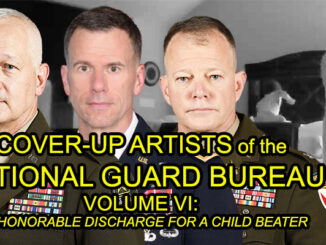Whoa! Wait a just a damn minute here. An active duty vice admiral kills himself? At the risk of sounding like a conspiracy nut, something does not smell right here. Countless murders in military have been covered up by the military by alleging the person committed suicide.
People who are suspicious about military suicides jokingly say the person was probably “suicided.” The term “suicided” is a mocking, made-up code word that says the person didn’t actually commit suicide, but was probably murdered and the murder is being covered-up as a suicide. So, it begs the question, did VADM Scott Stearney commit suicide, or was he “suicided?”
WE REMEMBER JAMES FORRESTAL

There are people who still believe that James Forrestal was murdered and did not commit suicide. Forrestal was SECNAV and SECDEF but never an admiral in the Navy as we first reported. He was an officer in the Navy, but did not attain flag rank. Thank you to reader “Matt” who corrected that error. The official line on what happened to James Forrestal goes as follows…
Forrestal told associates he had decided to resign, he was allegedly surprised when President Harry Truman asked for his resignation as Secretary of Defense. His letter of resignation was tendered on March 28, 1949.
On the day of Forrestal’s resignation from office, he allegedly is said to have gone into a strange daze and was flown on a Navy airplane to the estate of Under Secretary of State Robert A. Lovett in Hobe Sound, Florida, where Forrestal’s wife, Josephine, was vacationing.
Dr. William C. Menninger of the Menninger Clinic in Kansas was consulted and he diagnosed Forrestal as having “severe depression” of the type “seen in operational fatigue during the war”.
The Menninger Clinic had successfully treated similar cases during World War II, but Forrestal’s wife, his friend and associate Ferdinand Eberstadt, Dr. Menninger and Navy psychiatrist Captain Dr. George N. Raines decided to send the former Secretary of Defense to the National Naval Medical Center (NNMC) in Bethesda, Maryland.
Forrestal was checked into NNMC five days later. There was a decision to house James Forrestal on the 16th floor instead of the first floor. Forrestal’s condition was officially announced as “nervous and physical exhaustion”; his lead doctor, Captain Raines, diagnosed his condition as “depression” or “reactive depression”.
As a person who prized anonymity and once stated that his hobby was “obscurity”, Forrestal and his policies had been the constant target of vicious personal attacks from columnists, including Drew Pearson and Walter Winchell. Pearson’s protégé, Jack Anderson, later asserted that Pearson “hectored Forrestal with innuendos and false accusations”.
Forrestal seemed to be on the road to recovery, having regained 12 pounds since his entry into the hospital. However, in the early morning hours of May 22, 1949 the admiral’s body, clad only in the bottom half of a pair of pajamas, was found on a third-floor roof below the sixteenth-floor kitchen across the hall from his room.
Forrestal’s alleged last written statement, touted in the contemporary press and later biographers as an implied suicide note, was part of a poem from W. M. Praed’s translation of Sophocles’ tragedy Ajax. The truth may never be known as to whether Forrestal was murdered, committed suicide or was driven to suicide which is also murder.
There is someone out there who knows what really happened to Vice Admiral Scott Stearney. MilitaryCorruption..com has our ears opened if you want to tell us what really happened to Vice Admiral Stearney and the story behind it.
- Here’s one “official” report on the Stearney “suicide.”

- Vice Admiral Scott Stearney, who oversaw US Navy forces in the Middle East, was found dead on Saturday in his residence in Bahrain, according to navy officials. The Naval Criminal Investigative Service and the Bahraini Ministry of Interior are cooperating on an investigation. However, no foul play was suspected.
- “This is devastating news for the Stearney family, for the team at 5th Fleet, and for the entire Navy,” Chief of Naval Operations Admiral John Richardson said in a video statement. “Scott Stearney was a decorated naval warrior. He was a devoted husband and father, and he was a good friend of all of us,” Richardson said.
- Stearney was the commander of US Naval Forces Central Command and of the US Navy’s Bahrain-based Fifth Fleet, which is responsible for patrolling the Gulf, the Strait of Hormuz, Red Sea, Arabian Sea and parts of the Indian Ocean.
- In recent years, the fleet has dealt with potential threats from pirates and weapons smugglers as well as Iranian Revolutionary Guard boats and Houthi rebels firing missiles at commercial ships from Yemen.
- In 2004, the fleet’s surface warships were ordered to hold an “ethics, trust, responsibility and mission stand down” after two sailors were accused of stealing money and other valuables during an inspection of a Singaporean vessel in the Gulf.
- Born in Chicago, Illinois, Stearney graduated from the University of Notre Dame with an economics degree before joining the US Navy in 1982. Two years later, he became a pilot and logged more than 4,500 flight hours over the course of his career, which also included stints as a trainer and service in Afghanistan.
- In May, Stearney was appointed as commander of the US Naval Forces Central Command and of the Fifth Fleet, positions he occupied until his death. Rear Admiral Paul Schlise, the deputy commander of Fifth Fleet, has assumed its command, while Vice Admiral James Malloy, a deputy chief of naval operations, is preparing to fly out to Bahrain to take command in the interim. Further information is expected as the investigation continues.
- VADM Stearney was the Commander of the 5th Fleet. For those who might need a refresher course on the Navy’s fleet breakdown, here it is according to Wikipedia…
| Numbered Fleet | Status | Parent Command | Notes |
|---|---|---|---|
| 1st Fleet | Inactive | Pacific Fleet | The First Fleet existed after World War II from 1947, but was re-designated Third Fleet in early 1973. The United States Coast Guard is sometimes believed to act as the First Fleet in wartime; however, the United States has never officially used this reference and it is informal at best. |
| 2nd Fleet | Active | Fleet Forces Command | The Second Fleet was re-designated from the Second Task Fleet in 1950 as part of United States Fleet Forces Command in the Atlantic. It was deactivated in 2011, but later reactivated on May 4th 2018. |
| 3rd Fleet | Active | Pacific Fleet | The Third Fleet was re-designated from First Fleet in early 1973. |
| 4th Fleet | Active | Naval Forces Southern Command | The Fourth Fleet was active during World War II and deactivated in 1950 when its responsibilities passed to Second Fleet. It was reactivated in 2008. |
| 5th Fleet | Active | Naval Forces Central Command | The Fifth Fleet was deactivated in 1947 after serving during World War II. It was reactivated in 1995 to assume responsibilities in the Persian Gulf previously assigned to Seventh Fleet. |
| 6th Fleet | Active | Naval Forces Europe | The Sixth Fleet was re-designated from Sixth Task Fleet in 1950 and has been continuously active in the Mediterranean since. |
| 7th Fleet | Active | Pacific Fleet | The Seventh Fleet was activated in 1943, re-designated Naval Forces Western Pacific in 1947, Seventh Task Fleet in 1949 and to its current designation in 1950. |
| 8th Fleet | Inactive | Atlantic Fleet | The Eighth Fleet was established in 1943 from Northwest African Force. It operated in the Mediterranean Sea during World War II, with its forces briefly reassigned to Twelfth Fleet. From 1946-47 served as the heavy striking arm of the United States Atlantic Fleet before being re-designated Second Task Fleet and later Second Fleet. |
| 9th Fleet | Inactive | Atlantic and Pacific | Before 15 March 1943, Commander, U.S. Naval Forces Europe served as Commander Task Force 99, of the 9th Fleet, which was under the direct command of Admiral King. On 15 March 1943, TF 99 was re-designated TF 92. On 15 August, the 9th Fleet was re-designated 11th Fleet, still under the direct command of Admiral King, and TF 92 was re-designated TF 112. Task Forces in the 90s series have been used since World War II. In 1945, under Admiral Nimitz, CINCPOA, as Commander Ninth Fleet, Task Forces 90-92 formed the North Pacific Force, and the higher numbers were used for Strategic Air Force, POA, and local defences (Marshals-Gilberts Force, Hawaiian Sea Frontier, etc.). Naval Forces Far East used 90-series task forces in Korea. |
| 10th Fleet | Active | Fleet Cyber Command | The Tenth Fleet was active during World War II and reactivated in 2010 for assignment to Fleet Cyber Command. |
| 11th Fleet | Inactive | Pacific Fleet and Atlantic Fleet | Re-designated on 15 August 1943 from 9th Fleet and subsequently transferred to Atlantic Fleet |
| 12th Fleet | Inactive | Naval Forces Europe | The Twelfth Fleet was active in European waters during World War II. It was redesignated United States Naval Forces Mediterranean in 1946, which later became Sixth Task Fleet. |
Additional numbered fleets have existed; for a period after World War II, the Sixteenth and Nineteenth Fleets were assigned as the reserve elements for Atlantic and Pacific Fleets.



